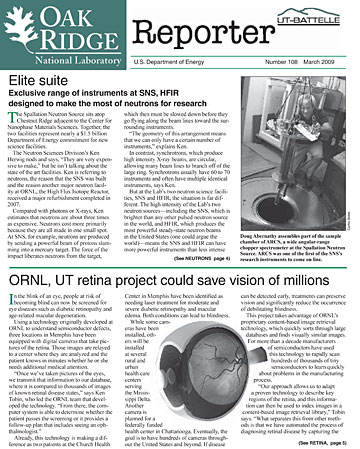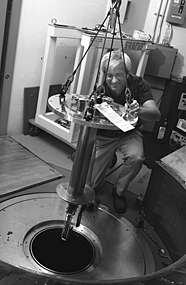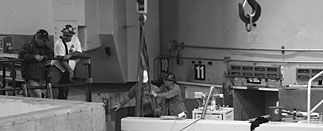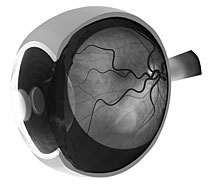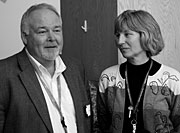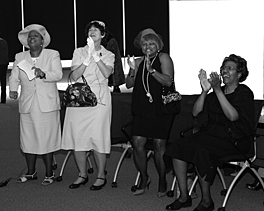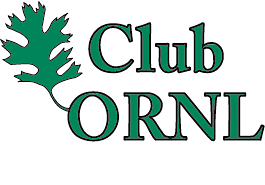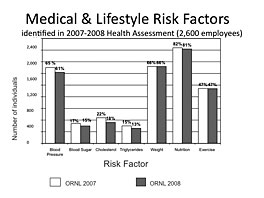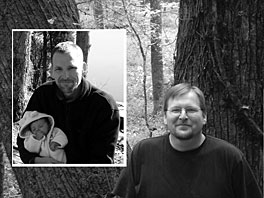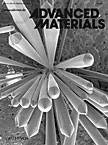 |
Number 108, March 2009 |
 Elite suite
Elite suite
Exclusive range of instruments at SNS, HFIR designed to make the most of neutrons for research
|
|
Doug Abernathy assembles part of the sample chamber of ARCS, a wide angular-range chopper spectrometer at the Spallation Neutron Source. ARCS was one of the first of the SNS’s research instruments to come on line. |
The Spallation Neutron Source sits atop Chestnut Ridge adjacent to the Center for Nanophase Materials Sciences. Together, the two facilities represent nearly a $1.5 billion Department of Energy commitment for new science facilities.
The Neutron Sciences Division’s Ken Herwig nods and says, “They are very expensive to make,” but he isn’t talking about the state of the art facilities. Ken is referring to neutrons, the reason that the SNS was built and the reason another major neutron facility at ORNL, the High Flux Isotope Reactor, received a major refurbishment completed in 2007.
Compared with photons or X-rays, Ken estimates that neutrons are about three times as expensive. Neutrons cost more primarily because they are all made in one small spot. At SNS, for example, neutrons are produced by sending a powerful beam of protons slamming into a mercury target. The force of the impact liberates neutrons from the target, which then must be slowed down before they go flying along the beam lines toward the surrounding instruments.
“The geometry of this arrangement means that we can only have a certain number of instruments,” explains Ken.
In contrast, synchrotrons, which produce high intensity X-ray beams, are circular, allowing many beam lines to branch off of the large ring. Synchrotrons usually have 60 to 70 instruments and often have multiple identical instruments, says Ken.
But at the Lab’s two neutron science facilities, SNS and HFIR, the situation is far different. The high intensity of the Lab’s two neutron sources—including the SNS, which is brighter than any other pulsed neutron source in the world, and HFIR, which produces the most powerful steady-state neutron beams in the United States (one could argue the world)—means the SNS and HFIR can have more powerful instruments than less intense sources, but there is still a limit to the number that can fit around the neutron source.
The limited real estate around a neutron source’s beam lines means each instrument is highly optimized to get the best information out of it. “You will rarely find duplicate instruments at a neutron source,” Ken says.
Instruments can be optimized in many different ways, but there are two major parameters that neutron scattering instruments measure, says Ken: The direction that the neutrons are traveling and the velocity or speed at which they are traveling.
“Each instrument is specialized to measure the physical properties of materials by focusing on one or the other of those two parameters very closely,” he says. The way the neutrons change their speed or direction as they travel through the sample reveals physical characteristics of the material, so the instruments are optimized to monitor those changes in hopes of better characterizing certain materials’ properties.
“The science that the researcher is focused on will determine which instrument or group of instruments she will use, because each one is uniquely designed to detect different types of material’s characteristics and behaviors,” Ken says.
And in neutron science, just like everywhere else, form pretty much follows function. Ken points out that each instrument looks very different from the one next to it. Because a long flight path allows the instrument to measure neutron velocity much more exactly, he explains, the instruments that are optimized to measure neutron velocity are often extended in length.
“The longest instrument is 84 meters, about the length of a football field,” Ken says.
Besides those two parameters, instruments are also specialized by tweaking the neutron detection systems and adding pressure chambers and furnaces so that materials can be analyzed under extreme environments. Using these specialized instruments, researchers hope to mimic the effects of the high pressures experienced at the core-mantle boundary deep inside the earth, or the incredibly high temperatures and stresses inside of a jet engine, for example.
Other differences among the neutron scattering instruments at ORNL’s neutron facilities originate from the beams themselves.
|
The SNS target hall remains a construction zone as workers install new beam lines and instrument bays. |
SNS provides a beam of neutrons that is pulsed, while HFIR’s beam is steady, providing two very different ways to probe materials. Having the two types of neutron beams available at one location is a great resource for users and extends their ability to characterize the materials they are looking at, Ken explains.
“HFIR has a world-class cold source,” says Ken, explaining that HFIR supplies higher intensities of the slowed-down cold neutrons than anywhere else in the world. Cold neutrons are better for studying larger materials like protein structures or the polymers used to make better plastics.
On the other hand, the thermal neutrons at HFIR are optimal for analysis of crystalline or metallic materials like superconductors for better electronics or stress and strain mapping for engineering applications. And the pulsed neutrons at SNS enable researchers to look at materials yet another way: The instruments at SNS are optimized for broader materials characterizations, so researchers can get a detailed survey of the responses of a sample much more quickly than is possible at HFIR, Ken says.
“The neutron scattering instruments at SNS and HFIR all have different roles, optimized for various areas of research,” Ken continues. “But they are also very complementary, and each facility does what it does better than anywhere else in the world.”—Sarah Wright ![]()
SNS, HFIR build stable of scattering instruments
At the close of 2008, ORNL researchers in the Neutron Sciences Division were celebrating more than just the holidays as three more neutron scattering instruments became operational in rapid
succession.
At SNS, both the Extended Q-Range Small-Angle Neutron Scattering Diffractometer (EQ-SANS) on beam line 6 and the Powder Diffractometer (POWGEN) on beam line 11a received their first neutrons. Meanwhile, across the valley at HFIR, the Powder Diffractometer was turned on for the first time, increasing researchers’ abilities to study materials under extreme conditions.
EQ-SANS received its first neutrons just before Christmas, on December 23. EQ-SANS is designed to study noncrystalline, nanoscale materials. The instrument should open new opportunities for studies in life science, materials research, and earth and environmental science. Everyday applications include improved polymers; better detergents, soaps, and similar materials; more effective drugs from protein studies; and improved materials for the oil industry.
The SNS’s new powder diffractometer, POWGEN, is designed to study polycrystalline materials and will offer users greater flexibility and higher precision than most existing diffractometers. Scientific research using this instrument will investigate a wide range of magnetic and non-magnetic materials that are critical to advances in applications such as superconductors, high capacity lithium batteries, solid-oxide fuel cells and hydrogen storage.
HFIR’s newest addition, a Neutron Powder Diffractometer on Beam Line HB-2a, excels at structural studies of the crystalline and magnetic properties of technologically important powdered and ceramic samples under extreme conditions. The instrument enables scientists to investigate the effects of temperature extremes, both hot and cold, and of strong magnetic fields on the structural properties of materials including phase transitions, thermal expansion and residual stress. Possible applications include improved catalysts, stronger cements and alloys, higher-temperature superconductors and more powerful magnets.
The next step for these instruments is commissioning, where they are thoroughly tested and calibrated to make sure they operate consistently and reliably. Commissioning can last for three to six months, at which point they graduate to the user program and are available for scientists doing research experiments.
As the number of instruments in the user program continues to increase, 2009 promises to be a banner year for users. Last year brought 165 users to SNS and 258 to HFIR, says Ken Herwig, and for much of that time, SNS had only three instruments in the user program. —S.W.
 ORNL, UT retina project could save vision of millions
ORNL, UT retina project could save vision of millions
|
In the blink of an eye, people at risk of becoming blind can now be screened for eye diseases such as diabetic retinopathy and age-related macular degeneration.
Using a technology originally developed at ORNL to understand semiconductor defects, three locations in Memphis have been equipped with digital cameras that take pictures of the retina. Those images are relayed to a center where they are analyzed and the patient knows in minutes whether he or she needs additional medical attention.
“Once we’ve taken pictures of the eyes, we transmit that information to our database, where it is compared to thousands of images of known retinal disease states,” says Ken Tobin, who led the ORNL team that developed the technology. “From there, the computer system is able to determine whether the patient passes the screening or it provides a follow-up plan that includes seeing an ophthalmologist.”
Already, this technology is making a difference as two patients at the Church Health Center in Memphis have been identified as needing laser treatment for moderate and severe diabetic retinopathy and macular edema. Both conditions can lead to blindness.
While some cameras have been installed, others will be installed at several rural and urban health care centers serving the Mississippi Delta. Another camera is planned for a federally funded health center in Chattanooga. Eventually, the goal is to have hundreds of cameras throughout the United States and beyond. If disease can be detected early, treatments can preserve vision and significantly reduce the occurrence of debilitating blindness.
This project takes advantage of ORNL’s proprietary content-based image retrieval technology, which quickly sorts through large databases and finds visually similar images. For more than a decade manufacturers of semiconductors have used this technology to rapidly scan hundreds of thousands of tiny semiconductors to learn quickly about problems in the manufacturing process.
“Our approach allows us to adapt a proven technology to describe key regions of the retina, and this information can then be used to index images in a content-based image retrieval library,” Tobin says. “What separates this from other methods is that we have automated the process of diagnosing retinal disease by capturing the expert knowledge of an ophthalmologist in a patient archive.”
|
Tobin |
Leading the medical portion of the project is Edward Chaum, an ophthalmologist and Plough Foundation professor of retinal diseases at the University of Tennessee Health Science Center (www.eye.utmem.edu) Hamilton Eye Institute in Memphis. Chaum, the lead researcher on the National Eye Institute grant that has funded much of this research, is especially excited about the number of people, particularly the indigent and medically underserved communities, that this technology will help.
“Right now, with 21 million diabetics in the United States, we need to be screening 400,000 patients for diabetic eye disease every week,” Chaum says. “Less than half of these diabetics receive the recommended annual eye exam, which is absolutely essential to minimize serious eye complications and potential blindness.”
By 2050 the number of diabetics in the United States is expected to double, so the task of screening patients becomes even more daunting. Looking beyond the United States and more near term, the World Health Organization estimates that by 2025 more than 1 million patients will need to be screened worldwide for diabetes every day.
“To reach this goal, we are going to have to change the health care delivery paradigm,” Chaum says, “and that will mean distributing these cameras to clinics and offices of primary care physicians.”
Over the next few months, a more fully automated image analysis network managing images nationwide—and eventually worldwide—will be rolled out, according to Chaum, who envisions this being a global effort using automated technology and the connectivity of the World Wide Web.
In addition to Tobin, who directs the Measurement Science & Systems Enbineering Division, other researchers involved in the project are Tom Karnowski and Luca Giancardo of ORNL’s Measurement Science and Systems Engineering Division, Stacy Li of the University of Tennessee Health Science Center in Memphis and Karen Fox of the Delta Health Alliance.
The researchers have published a number of papers, most recently in Retina, The Journal of Retinal and Vitreous Diseases. The paper, titled “Automated Retinal Diagnosis by CBIR,” appears in Vol. 28, No. 10 (2008).
Additional funding for this project, begun in June 2004 through ORNL’s Laboratory Directed Research and Development program, has been provided by the National Eye Institute, The Plough Foundation, the Army Medical and Material Command, the University of Tennessee Health Science Center and the U.S. Health Resources and Services Administration.—Ron Walli ![]()
 ORNL launches Center for BioEnergy Sustainability
ORNL launches Center for BioEnergy Sustainability
|
University of Tennessee professor Tim Rials (left) spoke at the kickoff for the Center for BioEnergy Sustainability, directed by the Environmental Sciences Division’s Virginia Dale (right). |
A new ORNL center will help coordinate
and integrate Lab research activities that provide scientific data and analysis to ascertain the costs and benefits of raising, transporting and utilizing bioenergy crops.
The new Center for BioEnergy Sustainability will tap into the efforts of more than 80 ORNL scientists in fields that include energy, environment, biochemical engineering, economics, transportation and satellite data analysis.
Center Director Virginia Dale says the collaborative, interdisciplinary initiative will help connect scientists across ORNL so that they better understand the impacts and effects of bioenergy production systems and help discover ways to make them sustainable.
“Bioenergy will work, but we’ve got to be smart; we’ve got to do it right,” says Virginia, a landscape ecologist and ORNL Corporate Fellow who studies causes and effects of land-use changes. “This center will enable us to do that. Our goal is to be the world’s best source of high-quality data and analysis for bioenergy decision-makers and stakeholders.”
“Biofuels are an important part of the solution to energy security and reducing greenhouse gas emissions from fossil fuels,” ORNL Director Thom Mason said at a ceremony to dedicate the new center. “This center will provide opportunities for our staff to integrate their research on the scientific foundations to implement successful strategies, target realistic goals and understand potential effects of expanding bioenergy production and use.”
The new center announcement coincides with publication of an article by Virginia and ORNL colleagues in next month’s Issues in Science and Technology (www.issues.org).
The paper, titled “In Defense of Biofuels,” summarizes the ORNL team’s analysis of research data related to how biofuels impact the environment, the economy and other aspects of society.
Co-authors are Keith Kline, Russell Lee and Paul Leiby, all of the Environmental Sciences Division. Their conclusions include
- Biofuels are not a significant factor in food prices. Enough biomass is projected to be available to meet U.S. biofuel production goals of roughly 36 billion gallons by 2022 with minimal effect on food prices.
- In addition to energy benefits, biofuel feedstock production also can have positive impacts on wildlife, water quality and land conservation.
- There is little evidence that biofuels cause deforestation.
- The world’s productive lands are underutilized and increasingly degraded by mismanagement and the widespread use of fire. Properly managed biofuels crops could enhance productivity and help reduce poverty and deforestation.
Virginia says ORNL is already home to many unique resources that through enhanced communication can be better positioned to address bioenergy sustainability. Current examples include the following activities:
- ESD’s social scientists and ecologists are working to define sustainability in such a way that it can be measured and assessed over time.
- Researchers in ORNL’s Fuels, Engines, and Emissions Research Center are studying the effects of blending ethanol at greater than 10 percent in gasoline. Teaming with DOE and the National Renewable Energy Laboratory, the researchers last year launched a long-term study of 80 cars to learn more about the impact of higher ethanol blends on emissions, costs, engine life, and other factors over the life of the car.
- The Geographic Information Science & Technology group is developing a tool to collect and integrate data on the nation’s bioenergy infrastructures, including energy, transportation, water, agriculture and commerce. The system provides visualization, modeling and analysis of the complex interactions between these facets of bioenergy across space and time, which leads to better decisions about bioenergy production, practices and policies.
ORNL Corporate Fellow Virginia Dale discusses some of the goals and aspirations of the new Center for BioEnergy Sustainability with the University of Tennessee's Tim Rials. Watch.
To bring together these and other resources for a collaborative approach to bioenergy sustainability, the new center is hosting a Land-Use Change and Bioenergy Workshop, May 12-14, at Tellico West Conference Center, Grand Vista Resort, in Vonore, Tenn.—Mike Bradley ![]()
 Governor calls for
state solar institute
Governor calls for
state solar institute
Gov. Phil Bredesen has called for the creation of a “solar institute” for the state, comprising resources at ORNL, the University of Tennessee and the private sector.
“Solar power today is a tiny part of the power equation. It remains far too expensive, and it’s ripe for breakthroughs, there’s a lot of basic science to be done. We have the pieces—the building blocks—here in Tennessee to be major players in this area,” Gov. Bredesen said during his “State of the State” address on February 9.
The governor said tools such as ORNL’s Spallation Neutron Source and Leadership Computing Facility could help make the state a world center for solar power research. ![]()
 UT-Battelle, ATLC OK pact
UT-Battelle, ATLC OK pact
UT-Battelle and members of the Atomic Trades & Labor Council agreed to a new four-year contract. ATLC members ratified the agreement on April 13.
The new contract, which goes into effect in April running through April 2013, includes a four percent annual salary increase for the next four years for the approximately 650 ATLC members who work at ORNL, which is managed for DOE by UT-Battelle.
The agreement also provides Lab management a greater degree of flexibility in the assignment of work to union employees.
“The ATLC has played an important role in the growth that ORNL has enjoyed over the past several years,” Lab Director Thom Mason says. “The improvements we have made in both productivity and safety would not have been possible without our union employees. I look forward to continuing a great partnership.” ![]()
 |
 Intersections get “green” lights
Intersections get “green” lights
If things look different at the intersection of First Street and Bethel Valley Road, it may be more than the Oak Ridge S&T Park’s first building that has recently gone up. The Lab has installed new traffic lights at the intersection.
The new signals are illuminated by energy-efficient LED bulbs, which can lower energy costs by 80 percent or more. LED bulbs also have an added safety advantage in that they rarely fail at once. Instead they degrade over time, so signal upkeep can be basically a matter of scheduled maintenance.
|
ORNL intersections have a greener LED setup. |
ORNL’s Utilities Division has also installed LED signals at the Spallation Neutron Source and Melton Valley Road intersections. The “greener” lights are keeping with the spirit of the Lab’s emerging Sustainable Campus Initiative to become a more energy-efficient and conservation-conscious Lab over the next decade, says Utilities’ Charlie Bruce.
 Combination sheds light on new glass
Combination sheds light on new glass
A combination of neutron, X-ray and atom-probe analysis has given researchers previously inaccessible insight into the atomic structure of bulk metallic glasses. The research by a team led by the Neutron Scattering Science Division’s Xun-Li Wang has revealed the structure of the complex alloy—comprising zirconium, copper, nickel, aluminum and titanium—with potential applications from biomedical devices to sports equipment to aerospace structures.
Because of the experimental difficulty, the structure of nanocrystalline particles in metallic glasses has been a mystery for more than a decade.
“We combined in-situ scattering data from the Advanced Photon Source at Argonne, neutron scattering data from the Paul Scherrer Institute in Switzerland and atom-probe imaging from the University of Wisconsin to determine the structure of nanocrystalline particles in the alloy,” says Xun-Li.
“No one technique can solve everything. Combining the techniques and data analysis allowed us to visualize the structures, which will help us understand the properties of this material and, in the future, other advanced materials with special mechanical properties,” he says.
When fabricated under exact conditions, the alloy, which would normally be crystalline, becomes amorphous—a metallic glass—with special properties. Xun-Li says the atom-probe data, gathered by the Materials S&T Division’s Mike Miller at Wisconsin, was “brand new, with 1,000 times more atoms and therefore much better resolution.”
The research was featured on the cover of the January issue of Advanced Materials.
Researchers will be able to determine how these nanocrystalline particles evolve from the glass state when the new powder diffractometers at the Spallation Neutron Source and High Flux Isotope Reactor, currently in the commissioning phase, become fully operational.
“We’re just scratching the surface. Down the road we’ll be seeing and hearing a lot about these instruments” Xun-Li says.
 ‘ORNL kid’ lights up LA
theater scene
‘ORNL kid’ lights up LA
theater scene
Here’s an update on Teal Sherer, who is making a name for herself in the California acting community. We last saw her as the authentic, wheelchair-bound voter in one of a series of Liberty Mutual insurance company ads with a “doing the right thing” theme.
Teal’s mom is Suzanne Sherer in the Business & Information Services Directorate.
Teal’s most recent venture has been co-producer and actor in Who’s Afraid of Virginia Woolf? at the NoHo Arts Center in North Hollywood. Edward Albee’s jarring play is most famous as a movie featuring Elizabeth Taylor and Richard Burton.
Teal’s production received great reviews, including from the Los Angeles Times, and SOCAL magazine, which said Teal “nailed” the part of Honey.
Disabled in a car crash, Teal is communications director for the Screen Actors Guild Performers with Disabilties Committee and founded the theater company, Blue Zone, that staged Virginia. She continues to prove that disabled doesn’t necessarily mean unable.
 Whinny you feel like wanderin’
Whinny you feel like wanderin’
Something as big as a horse would seem to be hard to lose, but searchers spent the better part of a frigid week looking for Michael, a bay gelding that bolted from his hunting club rider on TVA property near the Oak Ridge Reservation on January 31.
The Safety Services Division’s Tom Christman, a volunteer searcher, said “he was the fastest horse in the club and nobody was going to catch him.”
With the cold weather and a bridle in his bit that could have gotten snagged, there was concern for the horse’s wellbeing.
However, the furtive steed apparently roamed a power-line right-of-way for the next six days as volunteers and at one point a helicopter looked for him. Searchers found hoof prints as far east as the ORNL water tower.
Then the horse doubled back toward the old Clinch River Breeder Reactor site, where he was spotted grazing on Friday, February 6, by a TVA crew clearing the power line.
By then a celebrity, Michael was greeted with a TV news crew and a radiological examination, which cleared him as good to go home.
Reported by Bill Cabage |
|
Renae Humphrey, Pat Parr, Quinty Bogus and Delores Cole groove to the Temptations at the Black History Month’s Motortown Revue, part of Feb. 24’s Soul Food Tasting event. |
 ORNL paper on iron-based superconductor
ranked as one of 2008’s most cited articles
ORNL paper on iron-based superconductor
ranked as one of 2008’s most cited articles
Although it was published halfway into the year, an ORNL paper on iron-based superconductors was 2008’s third-most cited article on superconductivity. The Nature paper, “Magnetic order close to superconductivity in the iron-based layered LaO1-xFxFeAs systems,” was issued on June 12.
A Japanese team’s discovery of the iron-based high-temperature superconductor rocked the materials world: Until then high-temperature superconductivity was exclusively the domain of cuprate, or copper-based, materials. Researchers raced to study it, including two teams at ORNL.
The Nature paper’s lead author was joint University of Tennessee and ORNL postdoc Clarina de la Cruz, and included UT-ORNL joint faculty member Pengcheng Dai and ORNL veteran neutron researcher Herb Mook. Part of the research cited in the paper was performed on the High Flux Isotope Reactor’s HB1A triple-axis spectrometer in addition to instruments at the National Institute of Standards and Technology.
The Nature paper had received 110 citations before the year was over.
Another ORNL team, led by the Materials S&T Division’s David Mandrus, fabricated a sample of the new material for its studies. Wigner Fellows Michael McGuire and Athena Safa-Sefat were the first in the United States to make samples of the lanthanum arsenic iron-oxide material.
That sample was also analyzed using HFIR’s triple-axis spectrometer.—B.C. ![]()
 Stimulus called
‘Manhattan Project-scale’ opportunity
Stimulus called
‘Manhattan Project-scale’ opportunity
Lab Director Thom Mason told staff members on February 26 that the effect of economic stimulus legislation on ORNL is “difficult to overstate.”
“The recent budgets represent the kind of ‘Manhattan Project’ scale commitment to sustainable energy that we have talked about for nearly two years. The President and the Congress have heard this message and are calling upon the national labs to help lead the response to a critical national priority,” Thom said in a Director’s Message to all Laboratory staff members.
The stimulus package could accelerate projects such as the central campus cleanup and construction of the new Chemical and Materials Sciences Laboratory, which will be situated across from Building 4500-North. Science programs, particularly those that are related to energy efficiency and renewable energy, also stand to gain.
“The wonderful aspect of this process is that we will soon have the resources to tackle many of the ideas we have worked on for years or even decades. But with these resources comes an obligation to see that the funds are used wisely and responsibly in a way that earns the trust of Congress and the public,” Thom said.
Just weeks after his inauguration, President Barack Obama spoke to DOE staff in Washington, citing “hundred of thousands of jobs” that could be created in manufacturing energy-efficient products such as solar cells and wind turbines, aided by stimulus funds. President Obama also called for the establishment of standards for energy-efficient home appliances.
ORNL is the largest of DOE’s energy research national laboratories, with a diverse research portfolio ranging from energy technologies to basic materials research.
“Our ability to balance the opportunities and responsibilities that come with the stimulus funding for energy will come down to whether we can work harder and smarter than at any time since most of us have been at ORNL,” Thom said. “If we can answer the call, it will be one of the most significant contributions in the Laboratory’s history.”—B.C. ![]()
 Club ORNL
Club ORNL
|
Get the details and latest news on Club ORNL online via the ORNL home page and on ORNL Today. Retirees, to gain access to the ORNL home page, first register in XCAMS by going to http://www.ornl.gov/adm/clubornl_signup.shtml. After receiving your XCAMS account and Club ORNL membership, retirees can then go directly to https://www.ornl.gov/adm/clubornl. Ross Toedte, 574-1912, toedterj@ornl.gov, is the retiree point of contact.
 Healthy inspirations
Healthy inspirations
Wellness Program is all about motivating staff members to take better care of their health
|
ORNL employees are getting serious about taking charge of their health. Aggregate data from the 2008 Mayo Clinic Health Assessment revealed that ORNL employees are at risk for excess weight (66%) and hypertension (61%), and have lifestyle risk factors relative to nutrition (80%) and stress (64%). When compared with the 2007 data, ORNL is trending in the right direction but we have a long way to go (see chart).
Not surprisingly, all these factors are related and a change in one area typically results in improvements across the board. Research reported by the Centers for Disease Control has shown that as weight increases, the risks for the following conditions increase as well: coronary heart disease, type 2 diabetes, cancers (endometrial, breast and colon), hypertension (high blood pressure), high total cholesterol or high levels of triglycerides, stroke, liver and gallbladder disease, sleep apnea and respiratory problems and osteoarthritis.
Furthermore, these health care issues have economic consequences. Up to 80 percent of all health care costs are attributed to unhealthy lifestyles.
The ORNL Wellness Program has tackled these issues head on, bringing in an exercise physiologist and registered dietician to work with employees, as well as offering weight loss programs, stress reduction seminars and full spectrum biometric and cardiovascular screenings. Employee response to these efforts has been overwhelmingly positive. Participation in all programs has been at capacity since the launch of the Reward Points Plus incentive program last November.
A manager recently shared: “I just wanted to let you know what a motivator the new wellness rewards program has been for me and my staff. I’ve started exercising again for the first time in years. I quit my Nicorette habit cold turkey, which I have had for over 12 years. In addition, I recently had my annual physical with my primary care physician and he is going to let me try to wean myself off of my blood pressure meds that I have been on for years. I have attended all the seminars held when time allowed and found them to be very informative. Many of my staff have also become motivated to lose weight and become healthier as a result of this program. The 750-point target looked pretty overwhelming at first but I’m almost there.”
Reward Points Plus works like this: You can earn points for living a healthy life style and for participating in a wide variety of wellness activities. As you earn points, you need to record them in the Mayo Clinic Embody Health portal, www.ornlwellness.com, under the “Reward Points” tab at the top on the home page. When you earn 750 reward points PLUS complete the Mayo Clinic Health Assessment when it is offered in the fall of 2009, you’ll receive a $30 monthly medical premium discount, beginning in January 2010.
The Reward Points incentive is available to all salaried ORNL employees who are primary policyholders of their ORNL medical insurance. Union employees and retirees are not eligible for the incentive.
You only have until Oct. 31, 2009, to earn your 750 Reward Points so, if you haven’t started yet, you need to get going now. If you’re visiting the Mayo Clinic site for the first time, you’ll need to register. The Reward Points tab includes the complete list of activities and more program details. Visit the site at www.ornlwellness.com and get started today.—Kathryn Cogar
 “I knew that voice but couldn’t find you.”
“I knew that voice but couldn’t find you.”
Employees are embracing the program and the results are inspiring. Here are a few stories:
Rex Veach, Quality Systems and Services
Division
“I have lost a total of 90 lbs since March 25, 2008. I am in the maintenance stage and keeping it off. The weight loss has healed my body from hypertension, snoring, sleep apnea and acid reflux.”
John Scircle, Nuclear & Radiological Protection Division
“I am down more than 30 pounds since weigh-in and hope to keep up the progress.”
Laura Chapman, F&O Logistical Services|
“Here’s some good news—I actually lost some weight in the last couple of weeks (of Santaclaustrophobia 2008). I had to get a smaller belt to hold my pants up; it’s one I haven’t used in several years. I plan on keeping this up. I lost weight in 2007 between Christmas and New Year’s, I can do it again.
“All my husband and I have done is cut back on the amount of food we eat. We eat what we like and want, just less of it. That way there are no cravings which cause you to overeat when you do eat something you’ve been avoiding.
“I have also tried (key word here) to cut back on how often I eat potatoes. I am a potatoholic! Haven’t started any exercising yet, but I’m still nursing a bum knee that I hurt back in April and had surgery on the end of May. It acts up every now and again. I haven’t had any setbacks, but some new stressors in the lives of my husband and myself have slowed down the weight loss process. I encourage everyone to keep doing what works for them. What works for some doesn’t always work for others. Wish me luck.
Robert Wagner, Energy & Transportation Science Division, National Transportation Research Center
|
The former Robert Wagner (right) and the new, nearly unrecognizable version (left). |
“I am located off-site so have been unable to use the fitness center. My focus has been mostly on walking and I am working up to running. I have always enjoyed walking and bought a Garmin ForeRunner to allow me to mix up the path and still keep track of distance and rate. Since I do not have easy access to a gym, I do “at home” workouts with pushups, situps and hiking. The “at home” strength training (beyond walking) is a new development which I probably should have been doing all along. I credit walking and “no second helpings” and “only eat half (when eating out on travel or otherwise)” for the weight loss.
I did use the Mayo Clinic Embody Health Website to keep track of weight for the multi-week weight loss program. I completed the “healthy weight” program and went from 301 to 180 lbs. I also read the nutrition and fitness resources regularly for ideas. The one thing I took away from all of this is that anyone can become and stay healthy. I have been hiking more than ever possible before and my brother (also an ORNL employee) and I are planning a trip to Colorado next summer to climb a +14,000-ft mountain.
“I lost 40 percent of my body weight over the past year, so I’m very focused and motivated to maintain. I check out the ORNL Wellness site for tips on a regular basis. I have a “park in the back” philosophy—take all opportunities to move more.
“Another interesting experience I had after the weight loss is that colleagues who I only see in person a few times a year at meetings did not recognize me. They would walk right past me and not say a word. At a meeting this fall, I was talking with several people and a researcher I know well from Sandia kept looking around whenever I spoke. It took him a few minutes to zero in on me. He said, “I knew that voice but couldn’t find you.”
Mark E Whitley, Physics Division, Holifield Facility
“As others have been encouraged through ORNL’s many initiatives, I have been working at losing weight, as well as getting back into better physical shape. Along those lines there are several difficulties I face even though I am only 51.
“Last year I started out walking around the pond five or six times for a 30-minute walk and was doing fine, I thought, until my hips went out on me, becoming inflamed and they had to be injected twice to reduce the swelling and pain. I ended up walking with a cane for a few months and wondering how I was going to keep in shape.
“Then this past December I finally found out why I was always fatigued and felt bad like I had the flu all the time. My doctor diagnosed me with fibromyalgia. With the proper prescription I feel better today than I have felt in probably at least the past five years. But I still have problems with arthritis in my hips, knees etc and was bummed that I couldn’t enjoy many activities that I would like to.
“Last weekend my daughter and I went out and purchased a Nintendo Wii system with the game packs and have been playing ‘indoor’ tennis, baseball, golf, & boxing with it and we’ve been getting more exercise then I ever imagined you could from a video game. Our arms were sore the next day and it didn’t hurt my hips, but I know it gave me an elevated heart beat-type workout. I was just mentioning this so if someone else has physical problems but want/need a solution (and can afford to buy this) that they would be greatly benefitted by it.
“And thanks for all of the encouragement that you, your staff, and ORNL personnel give to us Lab employees. It is really appreciated.”
 New Staff Members
New Staff Members
Kerry Dean Ewald and Yarom Polsky, NScD Neutron Facilities Development
Adrian Chad McCormick, Info. Technology Services
Daniel Steven Pelfrey, Center for Computational Sciences
Jeffrey Allen Proulx, NScD Research Accelerator
Dawn Marie Welch, Michael Wayne Strickland (re-hire) and David E. Sink Jr., Global Nuclear Sec. Technology
Travis James Wright, Business & Info. Services Dir.
Chris Dale Young, NScD Research Reactors (re-hire)
James Evrett Bell and Justin Christopher Keck, Contracts
Paula Pittard King Booker, Amanda Danielle Herrell and Hilda Marie Mynatt, Campus Support & Instru.
Harvey Edward Goranson, Safety Services
Deborah Lynne Holder, Computer Science and Math
Amy Richelle Hunt, Edwena Kay McIntire, Kristy Samantha Andreason and Michelle Denise Mazerolle, Human Resources Dir.
Laura Ann Anderson, Measurement Science & Systems Engr. Robert Lynn Gamble, Laboratory Protection
Kathy Johnston Graham, Energy & Engineering Sci.Dir.
Donna Jean Wilkerson, Computing & Computational Sciences Dir.
 ORNL People
ORNL People
The Environmental Sciences Division’s Pat Mulholland has been elected a fellow of the American Geophysical Union, an international scientific society with 50,000 members engaged in the study of the earth and space. He’ll be honored when the union meets in Toronto in May.
|
An ORNL and University of Georgia image for the article, “Zinc Oxide Microtowers by Vapor Phase Homoepitaxial Regrowth,” made the cover of Advanced Materials. The lead author is the University of Georgia’s Zhengwei Pan, who is also a member of ORNL’s Chemical Sciences Division. Other ORNL authors include the Chemical Sciences Division’s Parans Paranthaman and Sheng Dai and the Materials S&T Division’s John Budai.
The Materials S&T Division’s Claudia Rawn has been invited to serve as a member of the U.S. National Committee for Crystallography (USNC/Cr).
Will Minter, director of ORNL’s Asset Management and Small Business Programs Division, has received the Corporate Promotion of Higher Education award in the Black Engineer of the Year Awards 2009, for his contributions to science education, particularly students at historically black colleges and universities. The award is presented annually by Lockheed Martin Corporation, the Council of the Engineering Deans of the Historically Black Colleges and Universities, and U.S. Black Engineer & Information Technology Magazine.
Rowan Chakoumakos, son of the Neutron Scattering Science Division’s Bryan Chakoumakos, is a member of Oak Ridge High School’s winning Tennessee Science Bowl team. Rowan and his teammates will compete in the National Science Bowl in Washington, D.C., April 30-May 5.
William Mason, son of Lab Director Thom Mason, won the News Sentinel Southern Appalachia Regional Spelling Bee by spelling “vociferous.” The seventh-grader at Robertsville Middle School will compete in the Scripps Howard National Spelling Bee in Washington, D.C., in May.
Ron and Krystee Conaway have expressed their thanks to ORNL staff members who pitched in to a recovery fund after the couple’s Loudon County home burned shortly before Christmas. Ron works at the High Flux Isotope Reactor; Krystee works in Export Control. The house and contents were a total loss. “We have been humbled by the generosity and kindness shown by ORNL staff members after the loss of our home to fire,” say the Conaways. “We have been truly blessed with these contributions and greatly comforted by the concern of fellow
co-workers.”
